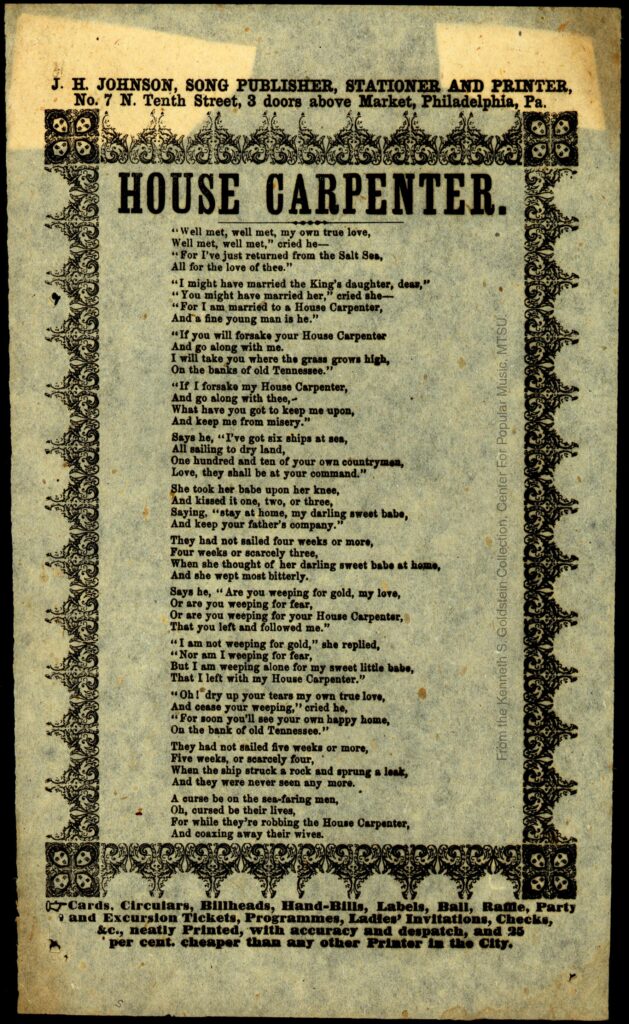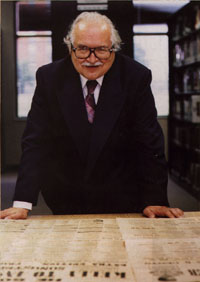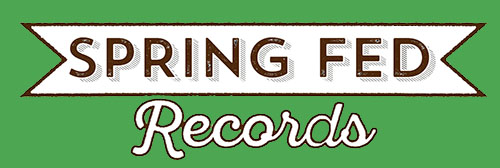Center for Popular Music
American Song Broadsides
Search Goldstein Broadsides
Introduction
Song broadsides were a common and inexpensive medium through which popular songs were commercially disseminated prior to the advent of sound recordings. Song broadsides—also known as song sheets or slip ballads—typically consist of a single sheet of paper, approximately 6” x 9”, with the lyrics of a song printed within a decorative border. Since they nearly always contained only text and no engraved music, broadsides were cheap and simple to produce. Many broadsides were text-only versions of popular songs that were also available in sheet music form from music publishers, but others contain songs that were published in no other medium.

The Kenneth S. Goldstein Collection held by the Center for Popular Music consists of nearly 3,300 American song broadsides, from more than 120 publishers. While most broadsides carry no publication date the items in the Goldstein Collection range from the late eighteenth to the early twentieth centuries, with the bulk having been published between 1840 and 1880. The collection provides an exceptional window through which to view and study American taste and culture of the time. Numerous older traditional ballads were printed in broadside form, as were contemporary narrative songs that documented natural disasters, battles, political events, social movements, tragic accidents, and the concerns of daily life. Sentimental and comic songs were plentiful.
The mission of the Center for Popular Music is to promote the study of American popular and vernacular music, with emphasis on the role of music as an integral part of American cultural and social history. These broadsides are historical documents. Many contain language and convey stereotypes that reflect the culture of a particular period or place in the past but that are regarded as offensive in modern times. They should therefore be viewed and studied in the context of theera in which they were created. They are presented as part of the historical record and do not necessarily represent the views of the Center for Popular Music or its staff.
The digitization and cataloging of the Goldstein collection was supported by a Preservation and Access grant from the National Endowment for Humanities. Work on the project was carried out from July 2003 to July 2005. Any views, findings, conclusions, and recommendations expressed in or on this website do not necessarily reflect those of the National Endowment for the Humanities.
About the Collection
Kenneth S. Goldstein, 1928-1995

Kenny Goldstein was a man of many facets who became an important friend of the Center for Popular Music late in his life. During his career he was a scholar, professor, folklorist, record producer, festival organizer and more. Most essentially, he was a collector who amassed a remarkable personal library of books, sheet music, song books, recordings and other materials. The Center was grateful to become the repository for Dr. Goldstein’s collection of American song broadsides and songsters shortly before his death in 1995.
What is a Broadside?
Song broadsides (sometimes also called song sheets, song slips, or slip ballads) were a common and inexpensive means through which popular songs and ballads were commercially disseminated throughout Northern and Western Europe, and the lands colonized by people from these areas, from the sixteenth to the early twentieth centuries. Broadsides normally contained only lyrics, as simple text was much easier and cheaper to typeset and print than was musical notation. Thus, whereas sheet music consumers were musically literate and possessed some degree of education and presumably some means, the audience for broadsides consisted of music-lovers who occupied a lower position on the social and economic ladder. Where a single piece of sheet music might sell for 25-60¢ a copy, broadsides sold for a penny. Sheet music was sold in music stores; broadsides in news stalls and bookstores, or at circuses, minstrel shows, medicine shows, political rallies, temperance meetings, and vaudeville performances. Sheet music was intended to be profitable; broadsides were so cheap that they sometimes functioned as promotional items for merchandisers of various sorts.
Sheet music was meant for the piano in the parlor; broadsides for the pocket. It was common practice for purchasers of sheet music to collate their collections and have them bound in handsome volumes (often with the owner’s name in gilt lettering on the cover) that lay in elegant repose on the music rack of the parlor piano. Broadsides rarely were accorded such pride of ownership. As a result relatively few survived, and they are quite rare today. Out of a total of approximately 65,000 items in the Center for Popular Music’s sheet music collection (in which the broadsides are included), there are only approximately 3,300 broadsides. The Kenneth S. Goldstein Collection of American Song Broadsides was assembled over a period of ten years through active, aggressive collecting on the part of the late Kenneth Goldstein, one of the country’s leading folklorists. At the time it was acquired by the Center for Popular Music in 1994 it was believed to be the largest private collection of such items in the country. It includes the products of more than 160 publishers.
The typical format of a song broadside is simple in design, consisting of a single sheet of paper with the lyrics of one or two songs (occasionally more) printed within a decorative border. They are of fairly consistent size (about 6″ x 9″) and are printed on inexpensive, thin paper. Most are black on white but some of the most interesting include color, either hand-tinted or printed. Most broadsides carry no publication date, but the items in the Goldstein Collection range from the late eighteenth to the early twentieth centuries, with the bulk falling roughly between 1840 and 1880. The size and relative uniformity of the materials makes the collection an ideal candidate for an efficient scanning and digitization project.
Song broadsides provide a window through which modern researchers can glimpse the musical tastes of everyday Americans of the nineteenth century. Many broadsides were text-only editions of the popular songs that were also available in sheet music form from music publishers, while others contain items that were published in no other medium. Numerous older traditional ballads were printed in broadside form, as were contemporary narrative songs that documented natural disasters, battles, political events, tragic accidents, and other aspects of daily life. Some broadsides include an indication of the melody to which the lyrics were supposed to be sung, but most did not. Purchasers were assumed to know the correct melody, or, as in the case of traditional folk singers, to supply one that they already knew and that was metrically appropriate. Often the songs on broadsides were parodies of well-known songs: e.g. “My Good Old Irish Home,” intended to be sung to the tune of “My Old Kentucky Home” by Stephen Foster.
However, the importance of broadsides is not limited to popular music historians. Folklorists have long recognized that broadsides occupy a crucial nexus between oral tradition and print. Though their heyday ended in the nineteenth century, broadsides continued to be an important form of dissemination in the South well into the twentieth century. Musicians such as Kentuckians J.W. Day and Dick Burnett sold printed “ballets” (i.e. ballads printed in broadside form), sometimes of older songs, and sometimes of their own compositions about important events such as murders or hangings. Much of the repertoire of the first generations of country music performers, and later ones with strong ties to tradition, can ultimately be traced to broadsides.
Because much of the song material contained in broadsides was topical in nature, these documents are also of importance to social and cultural historians. Tragedies, disasters, political campaigns, wars, battles, popular trends, and social movements were all chronicled and disseminated via broadsides. The song, “Hoops No. 2. What a Ridiculous Fashion,” issued by Andrews, in New York, illustrates the sort of social commentary that one can find in the songs published on broadsides. It was to be sung to the tune of the nineteenth-century popular song, “King of the Cannibal Islands.” The lyrics of this item describe in light humor the fashion of ladies wearing large hoop petticoats, and read in part:
Now Crinoline is all the rage with ladies of whatever age,
A petticoat made like a cage—oh what a ridiculous fashion!
‘Tis framed by with hoops and bars of steel, or tubes of air which lighter feel,
And worn by girls to be genteel, or if they’ve figures to conceal,
It makes their dresses stick far out, a dozen yards at least about,
And pleases both the thin and stout, oh, what a ridiculous fashion. This song gives insight into changes in fashion and the attitudes of those who were not pleased by the trend.
In some cases, the broadsides were published in a format that also served as stationery. Seventeen of the items in the Goldstein collection, all from the period of the Civil War, contain hand-written letters to friends and loved ones, and thus offer yet another level of documentation.
Although scholars and collectors have produced a fairly sizable body of work on the major music publishers of the nineteenth century, relatively little research has been done on the publishers of broadsides. The two industries were parallel; that is, music publishers did not publish songs in broadside form, and broadside publishers were not in the business of publishing and selling printed music. Some broadside publishers were also stationers, or printers of various other sorts of ephemeral items. Sheet music publishers and broadside publishers did apparently cooperate on some level, as some broadsides carried ads for the corresponding printed music: e.g., “The music of this song can be obtained at the store of Firth & Co., Franklin Square, N.Y.”
About the Project
Synopsis
The Center for Popular Music was awarded a National Endowment for the Humanities Preservation and Access grant to digitize and catalog the Kenneth S. Goldstein Collection of American Song Broadsides from July 2003 to July 2005. The purpose of this project is to provide greater awareness of and access to these fragile ephemeral documents that document a vital part of American culture.
The Goldstein digitization and access project consisted of: 1) scanning every item in the collection to create high resolution color TIFF (Tagged Image File Format) image files and then creating lower resolution JPEG (Joint Photographic Experts Group) files; 2) enhancing existing bibliographic records (presently available through an in-house database with a MARC-compatible field structure, using InMagic ® software) to add dates, full text of the song lyrics, subject headings, image links, and other appropriate information; 3) converting existing bibliographic records into MARC format for entry into the OCLC/WorldCat system; and 4) creating a website that provides the context for offering the digital images to the public.
Technical Notes
Each original song broadside was scanned using a Microtek ScanMaker 9600 XL flatbed scanner at 600 dpi and saved in TIFF format. From the master TIFF file, two JPEG files were created for Web access: one “thumbnail” image at 480 pixels and one printable image at 300 dpi with varying original dimensions. All files reside on the Center’s dedicated image server. Copies of the master image files were archived on Mitsui CD-R media and stored in a separate facility.
Catalog information for each song broadside title was entered and enhanced into the Center’s in-house database using InMagic ® DB/TextWorks 8.00 software. Catalog records were transferred from InMagic ® DB/Text to MARC format using MARCTransformer software. Records were then uploaded to the OCLC/WorldCat bibliographic utility using MicroEnhancer (CATME) and OCLC Connexion software.
Routine quality control inspections were made for both digital files and cataloging records. Master image files were checked for quality by sampling 10% of the TIFF image files at 100% magnification, or 1:1 pixel ratio for compliance with digital imaging guidelines. Quality control of the enhanced catalog records and re-keyed text was checked by various project staff members using a defined checklist, the spell check option in DB/Text, and comparison of the printed copy with the original.
While transcribing the lyrics of the song broadsides, every attempt was made to maintain the spelling, capitalization, and spacing of the original document. Brackets indicate omitted text or letters.
The Broadside website was created by project staff using Macromedia Dreamweaver and InMagic ® WebPublisher PRO. Graphic banners were created in Adobe Photoshop.
Staff
Paul F. Wells – Project Director
Lucinda P. Cockrell – Project Manager
Lacey Stockhem – Scanning Assistant
Christi Underdown – Cataloging Assistant
Shirley Wall – Administrative
Brenda Beasley – Cataloger
Dicky Dixon – Quality Control
Mayo Taylor – Grant co-writer and Cataloging Consultant
Marc Barr – Digitization Consultant
Acknowledgements
National Endowment for the Humanities for making the project possible.
AAS, especially Michael Gibney for the help with publisher dates.
Rosemary Kew for translating the French and German broadsides.
Guidelines and Disclaimers
Cultural Sensitivity
Any views, findings, conclusions, and recommendations expressed in or on this website do not necessarily reflect those of the National Endowment for the Humanities.
Copyright/Cited Materials
Preferred Citation: From the Kenneth S. Goldstein Collection of American Song Broadsides, Center for Popular Music, Middle Tennessee State University.
Reproduction Guidelines
Access Restrictions: None
Copy Restrictions: Duplication of images is allowed for research purposes. All original song broadsides are in the public domain. The user is responsible for all copyright compliance.
Related Links
American Repositories
American Antiquarian Society, Worcester, MA
America Singing, Nineteenth-Century Song Sheet, Library of Congress
Brown University John Hay Library Broadsides Collection
Enoch Pratt Free Library, Baltimore, MD
Franklin & Marshall College, Lancaster, PA — Broadsides of the German-American Imprint Collection
Library Company of Philadelphia
Middlebury College, Middlebury, VT — The Helen Hartness Flanders Ballard Collection
University of Mississippi Libraries — Kenneth S. Goldstein British Broadsides
European Repositories:
Other Broadside Resources:
Isaiah Thomas Broadside Ballads Project
Carriers’ Addresses: Brown University Library
Index of the Songs in Beadle’s Song Books, 1858 to 1870 — The House of Beadle & Adams
The Contemplator’s Short History of Broadside Ballads
Legends – Ballads and Broadsides
Indiana University, Bloomington, IN — Roud Folk Song Index and Broadside Index
Bibliography
Blanck, Jacob . Bibliography of American Literature / compiled by Jacob Blanck for the Bibliographical Society of America . New Haven : Yale University Press, 1955-1991.
Bumgardner , Georgia B. American broadsides; sixty facsimiles dated 1680-1800, reproduced from originals in the American Antiquarian Society. Selected & introduced by Georgia B. Bumgardner. Barre , Mass. , Imprint Society, 1971.
John Duffy. Early Vermont broadsides / introd. by Mason I. Lowance, Jr. Hanover, N.H. : Published for the University of Vermont by the University Press of New England , 1975.
Felcone, Joseph J. New Jersey broadsides before 1900 : a checklist of the Joseph J. Felcone collection. Princeton , N.J. : J.J. Felcone, 1991.
Ford, Worthington Chauncey . Broadsides, ballads, &c. printed in Massachusetts 1639-1800 . [ Boston ] : The Massachusetts Historical Society, 1922.
Ford, Worthington Chauncey. The Isaiah Thomas collection of ballads “Reprinted from the Proceedings of the American Antiquarian Society for April, 1923.” Worcester , Mass. , The Society, 1924.
Harvard University . Library. Catalogue of English and American chapbooks and broadside ballads in Harvard College Library, Compiled by Charles Welsh and William H. Tillinghast. Detroit , Singing Tree Press, 1968.
Hummel, Ray Orvin, ed. Southeastern broadsides before 1877 : a bibliography Richmond , Virginia State Library, 1971.
Dichter, Harry and Elliot Shapiro. Handbook of early American sheet music, 1768 1889 New York : Dover Publications, 1977.
Jantz, Harold Stein. The first century of New England verse. by Harold S. Jantz. . New York : Russell & Russell, 1962.
The Judgment of experts : essays and documents about the forgery of the Oath of a freeman. Worcester : American Antiquarian Society, 1991.
Laws, George Malcolm. American balladry from British broadsides; a guide for students and collectors of traditional song. Philadelphia, American Folklore Society, 1957.
Native American Balladry. Philadelphia , 1964.
Leach, MacEdward. The critics & the ballad. Readings selected and edited by MacEdward Leach and Tristram P. Coffin. Carbondale , Southern Illinois University Press [1961].
Library Company of Philadelphia . American song sheets, slip ballads, and poetical broadsides, 1850-1870; a catalogue of the collection of the Library Company of Philadelphia by Edwin Wolf 2nd. Philadelphia , 1963.
Lowance, Mason I., Jr. and Georgia B. Bumgardner. Massachusetts broadsides of the American Revolution.
McCorison, Marcus A. (Marcus Allen). Vermont imprints, 1778-1820; a check list of books, pamphlets, and broadsides. Worcester [ Mass.] American Antiquarian Society, 1963.
Moebs, Thomas Truxtun.U.S. reference-iana, 1481-1899 : a concise guide to over 4000 books and articles for researching art, books, broadsides, ephemera, manuscripts, newspapers, maps, pamphlets, photographs, and prints relating to that area within the present limits of the United States, 1481-1899./ specifically compiled for Americana collectors, booksellers and librarians by Thomas Truxtun Moebs. Williamsburg, Va : Moebs Pub. Co. , 1989.
Morris, Henry. Broadside vignettes : the poster/broadside format joined with the book. Newtown , Pa. : Bird & Bull Press, 1997.
Moss, William. Confederate broadside poems : an annotated descriptive bibliography based on the collection of the Z. Smith Reynolds Library of Wake Forest University. Westport : Meckler, c1988
Rice, Edward Le Roy. Monarchs of Minstrelsy: From “Daddy” Rice to Date . Kenny Publishing Company, New York City , N. Y., 1911.
Rudolph, Earle Leighton.Confederate broadside verse; a bibliography and finding list of Confederate broadside ballads and songs. New Braunfels, Texas, Book Farm, 1950.
Schrader, Arthur. Broadside ballads of Boston , 1813 : the Isaiah Thomas collection. Worcester , [ Mass.] : American Antiquarian Society, 1988.
Shepard, Leslie. The broadside ballad: a study in origins and meaning. Hatboro , Pa : Legacy Books, [1978] 1969?
History of Street Literature ( Detroit , 1973).
John Pitts: Ballad Printer of Seven Dials, London , 1765-1844 (1969)
Smith, Reed. South Carolina ballads, with a study of the traditional ballad to-day. collected and edited by Reed Smith. Cambridge , Harvard University Press, 1928.
Stoddard, Roger E. Poet and printer in colonial and federal America : some bibliographical perspectives. Worcester , Mass. : Published by the Society, 1983.
Stoddard, Roger E. Catalogue Of Books And Pamphlets Unrecorded In Oscar Wegelins Early American Poetry, 1650-1820. Providence , R.I. , Friends of the Library of Brown University , 1969.
Stoddard, Roger E. [ A catalogue of books and pamphlets unrecorded in Oscar Wegelin’s Early American poetry : further addenda ]. [ Amherst , Mass. : Early American Literature, 1979?]
Stoddard, Roger E. American bibliographical notes : fifth addenda to Wegelin’s Early American poetry. Worcester [ Mass. ] : American Antiquarian Society, c1990.
Sullivan, James D. On the walls and in the streets : American poetry broadsides from the 1960s. Urbana : University of Illinois Press , c1997.
Wegelin, Oscar. Early American poetry: a compilation of the titles of volumes of verse and broadsides by writers born or residing in North American north of the Mexican border. 2nd ed., rev. and enl. Gloucester , Mass. : P. Smith, 1965, c1930.
White, Peter, editor. Puritan poets and poetics : seventeenth-century American poetry in theory and practice. Peter White, editor; Harrison T. Meserole, advisory University Park : Pennsylvania State University Press, c1985.
Winslow, Ola Elizabeth. American broadside verse from imprints of the 17th and 18th centuries , selected and edited, with an introductory note, by Ola Elizabeth New Haven , Conn. , Yale University Press; London , H. Milford, Oxford University Press, 1930.
Wolfe, Richard J. Early American music engraving and printing : a history of music publishing in America from 1787 to 1825 with commentary on earlier and later practices. Urbana : Published in cooperation with the Bibliographical Society of America by the University of Illinois Press , c1980.
Contact Us
Center for Popular Music
Bragg Media & Entertainment Bldg.
Room 140
MTSU Box 41
1301 E. Main Street
Middle Tennessee State University
Murfreesboro, TN 37132
615-898-2449




